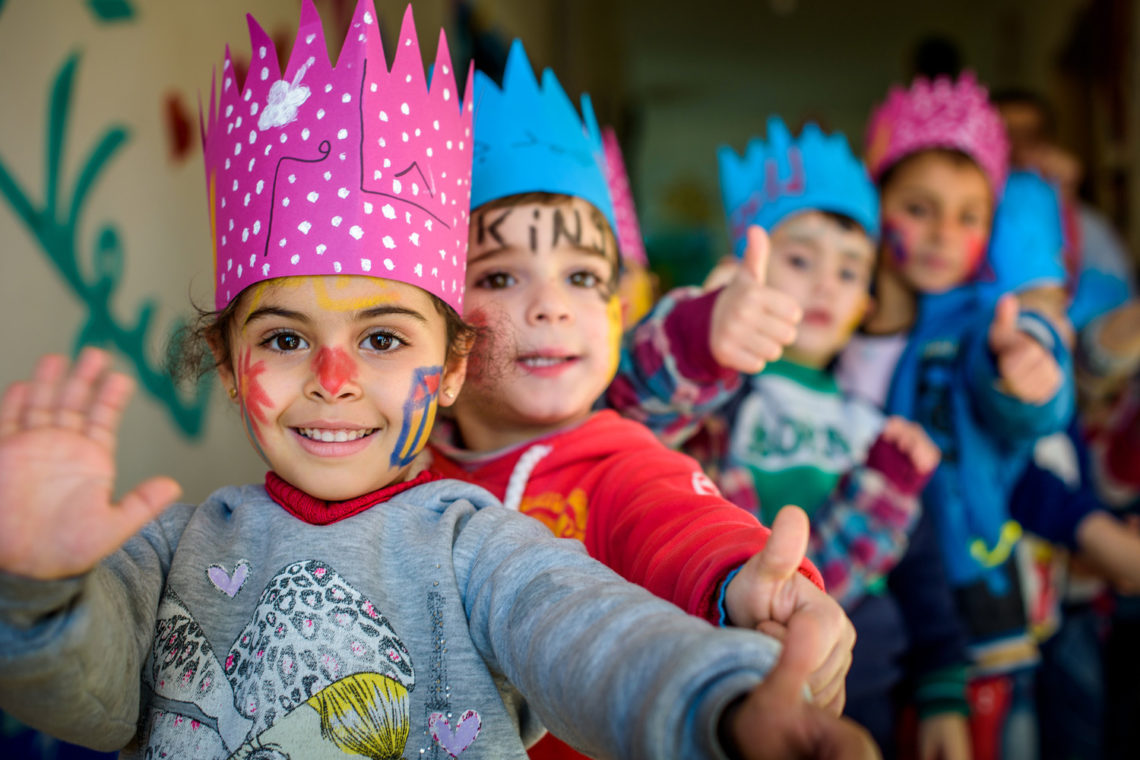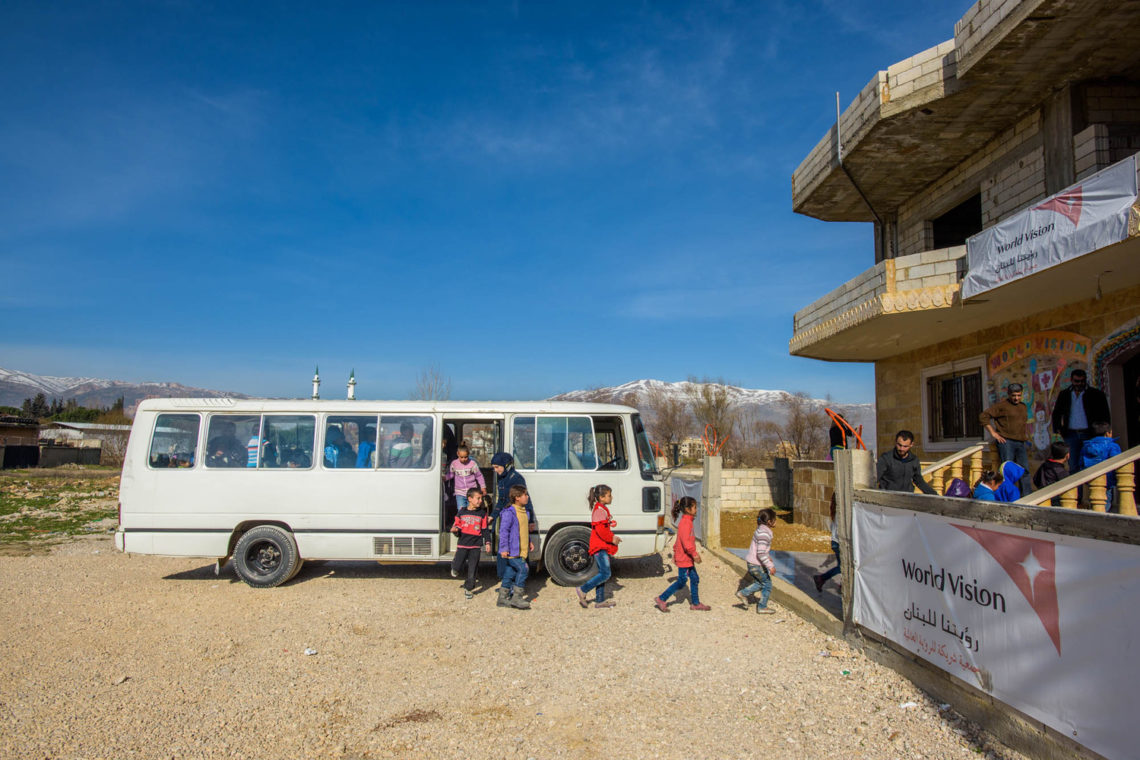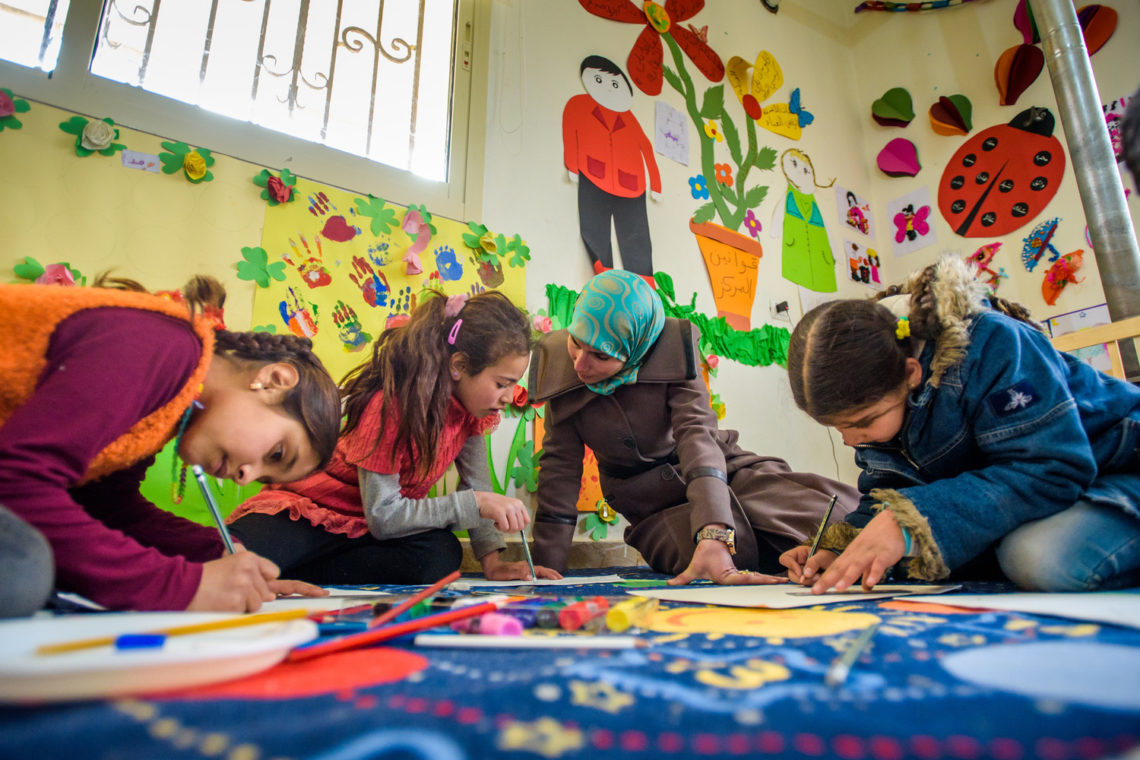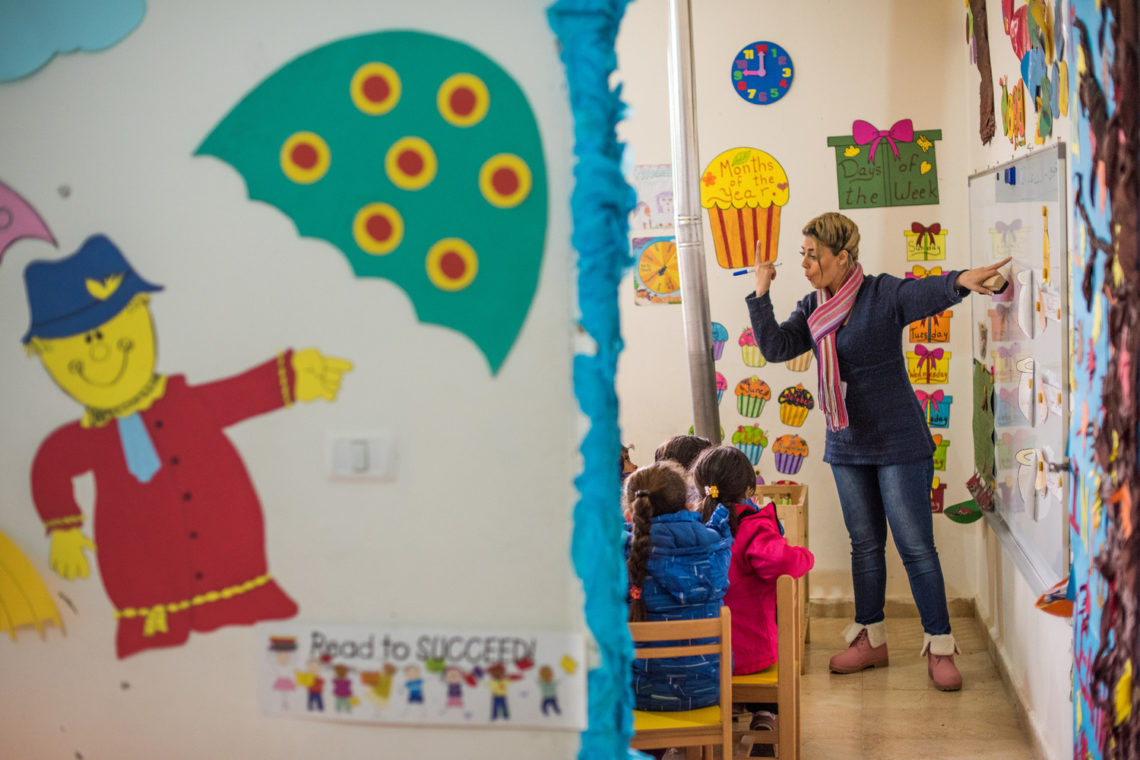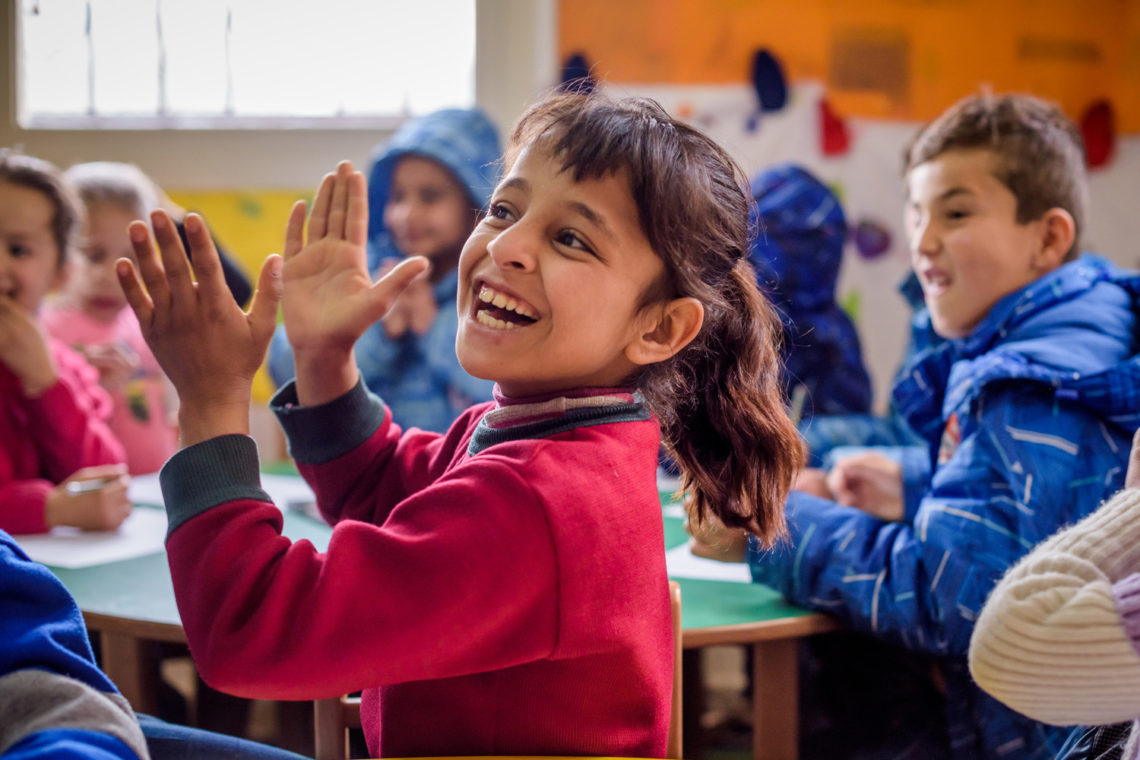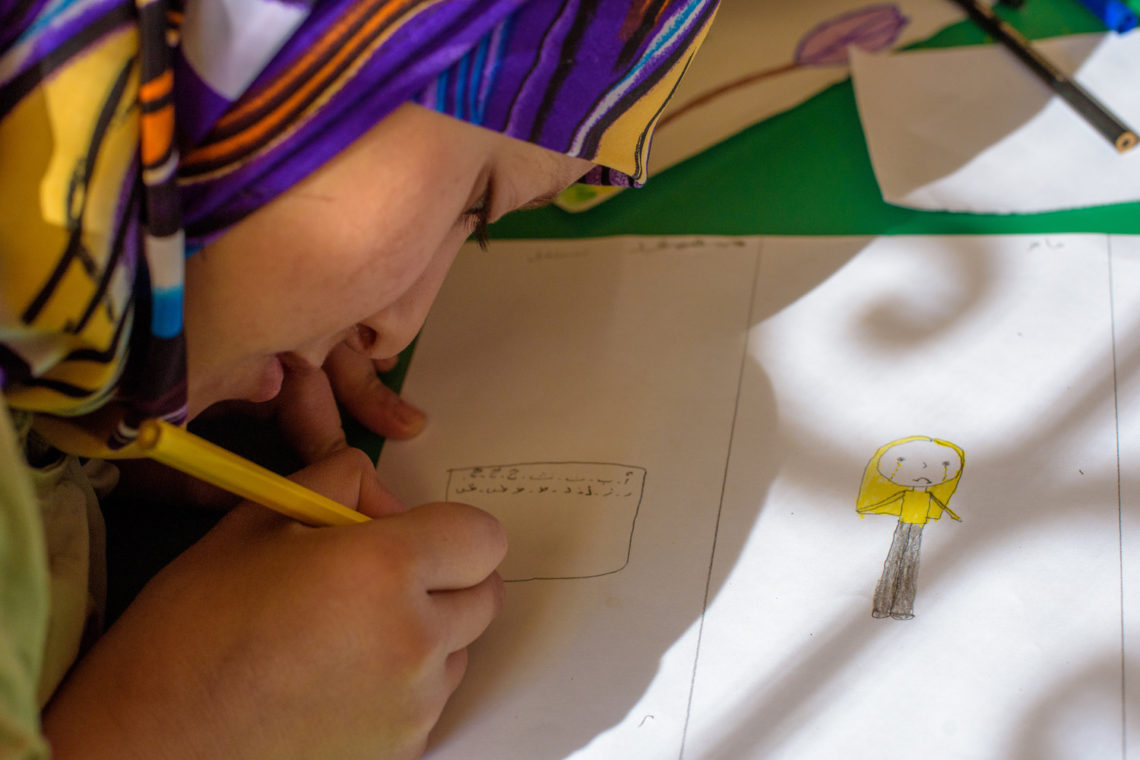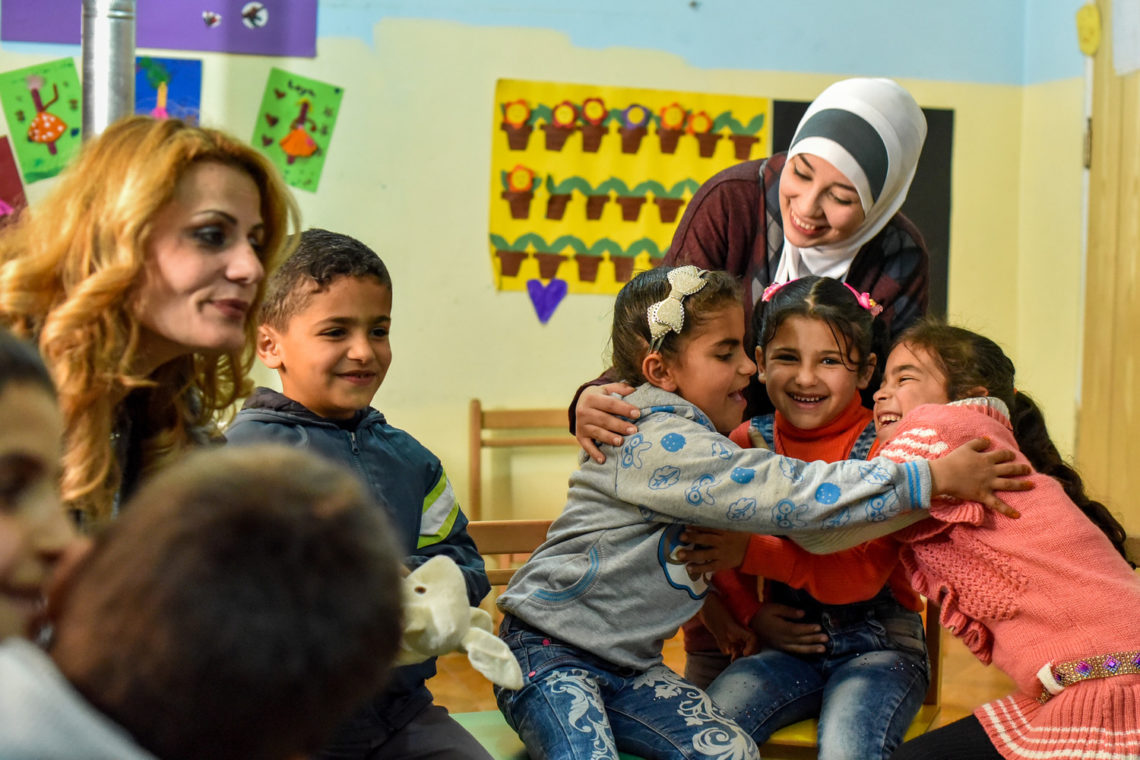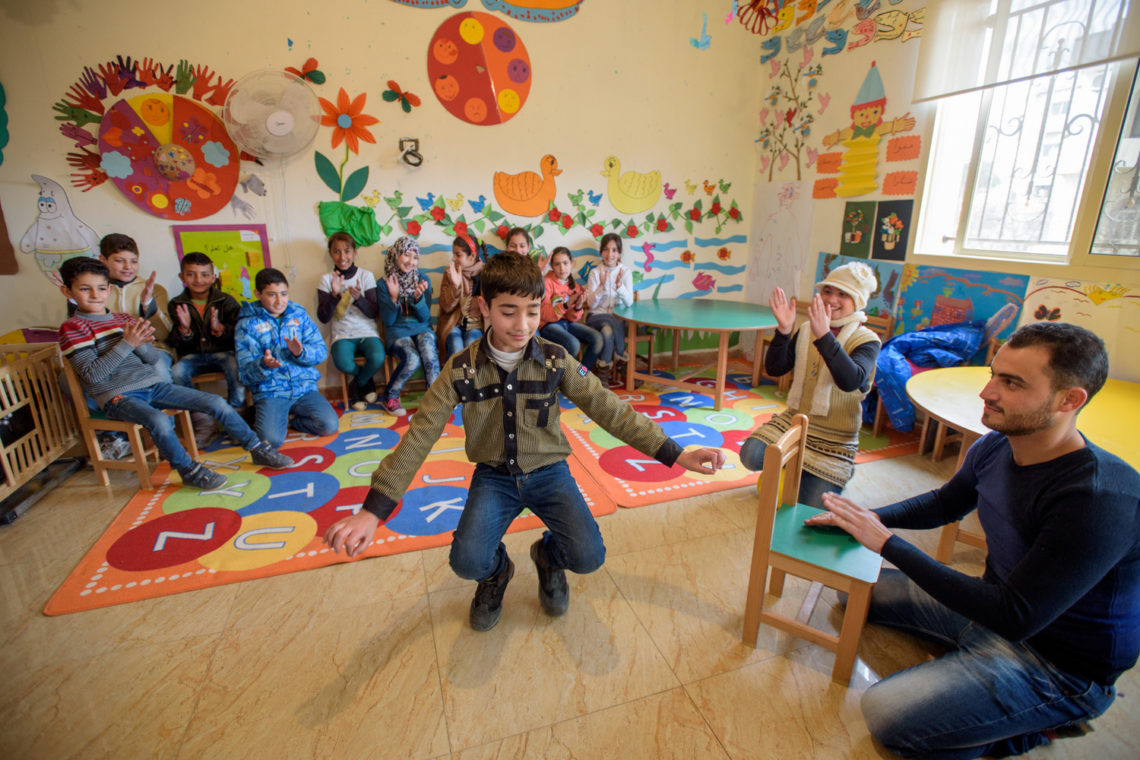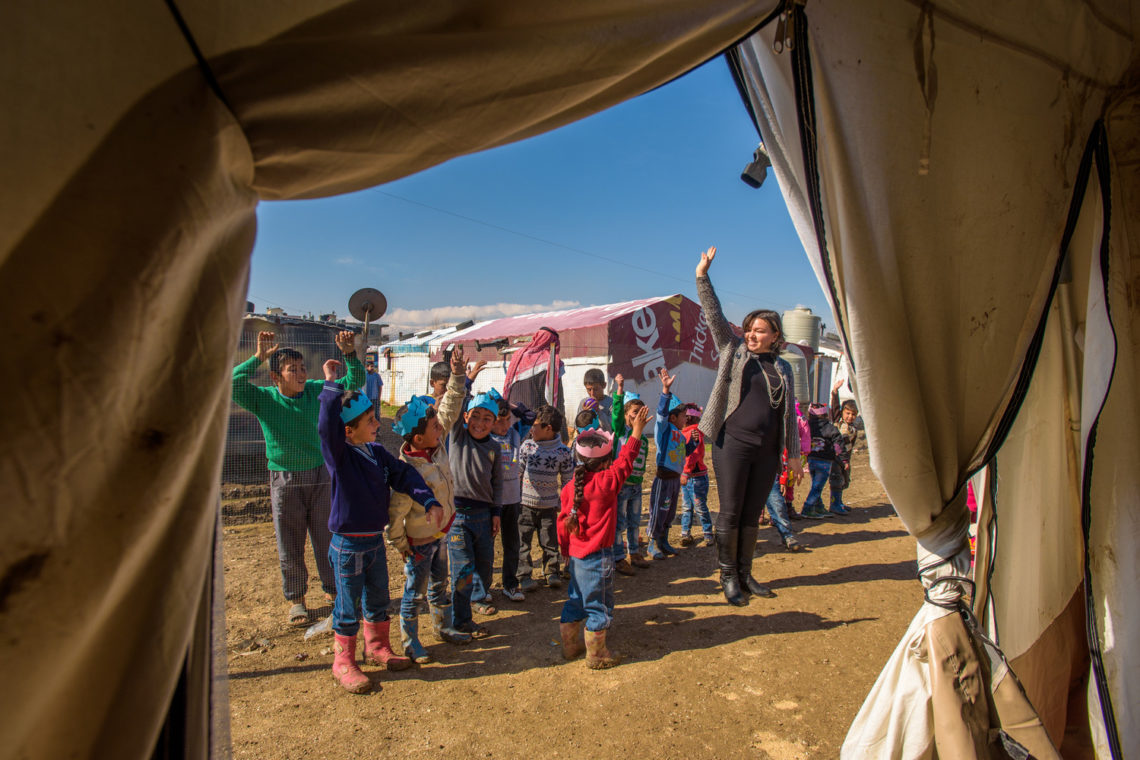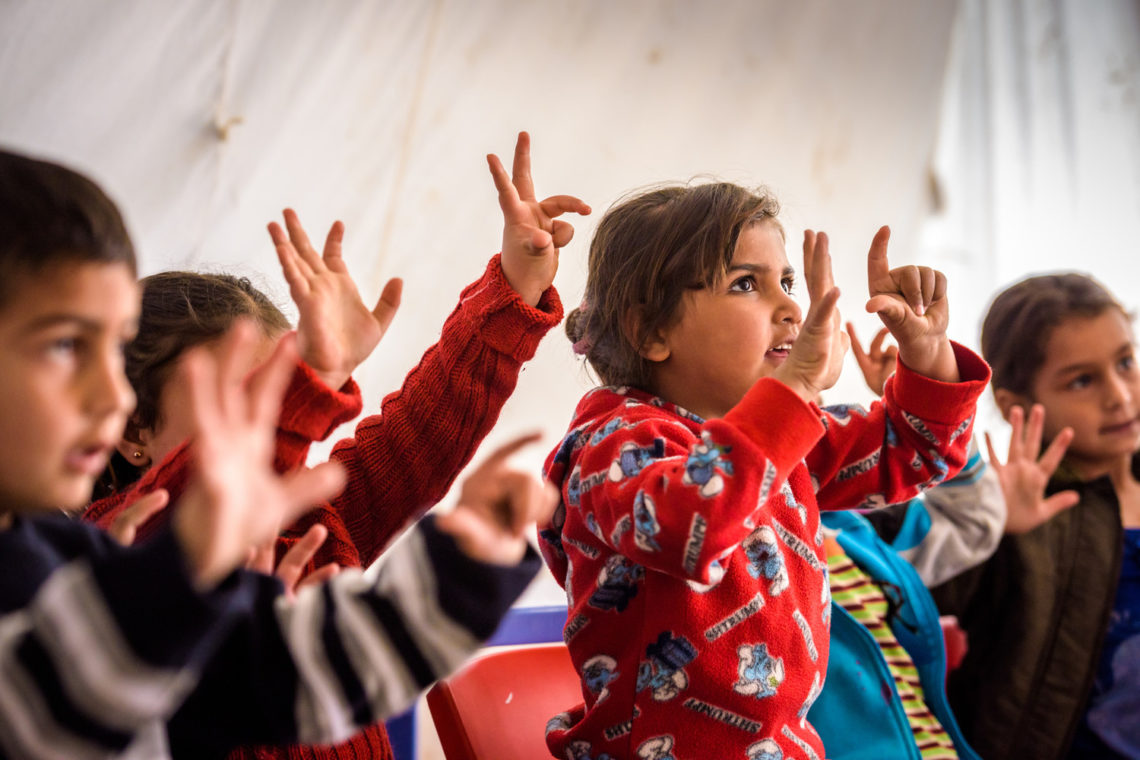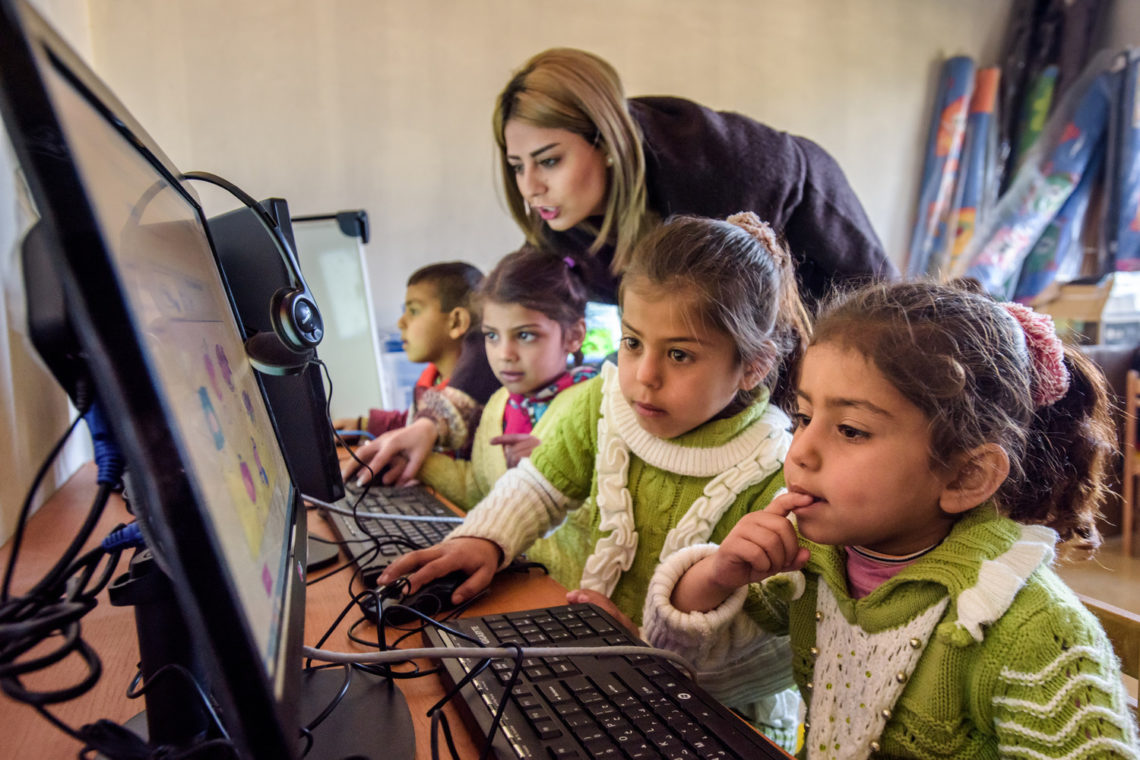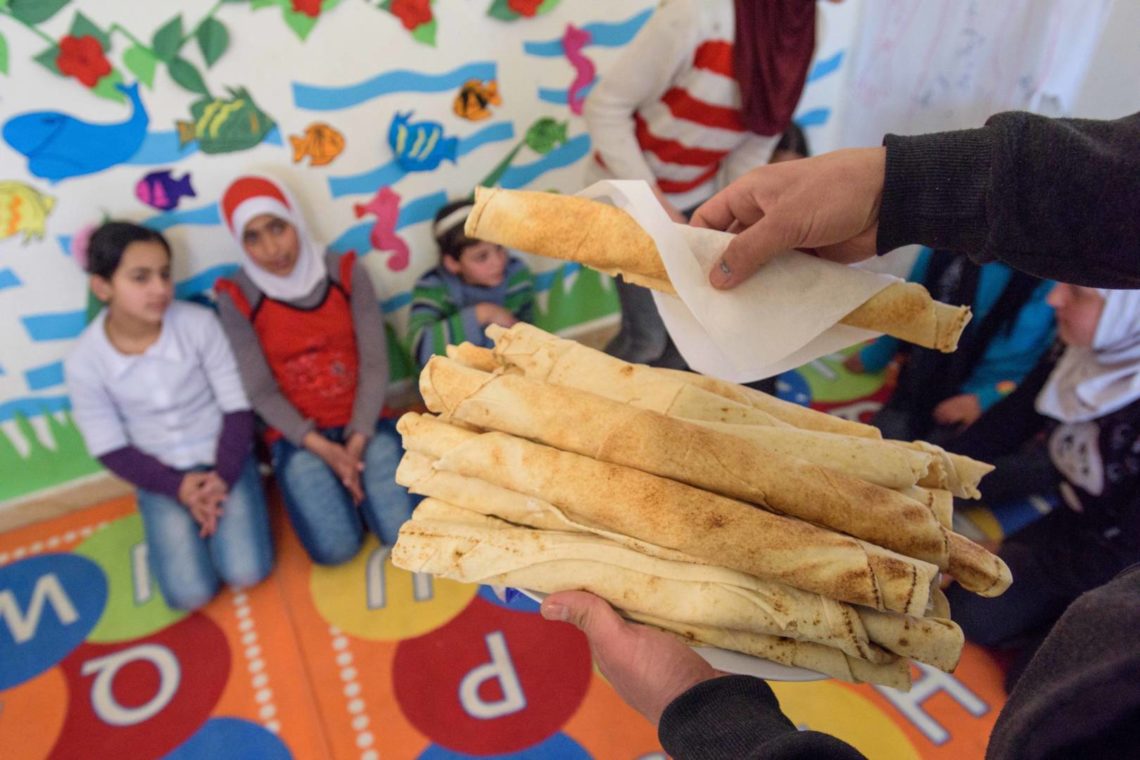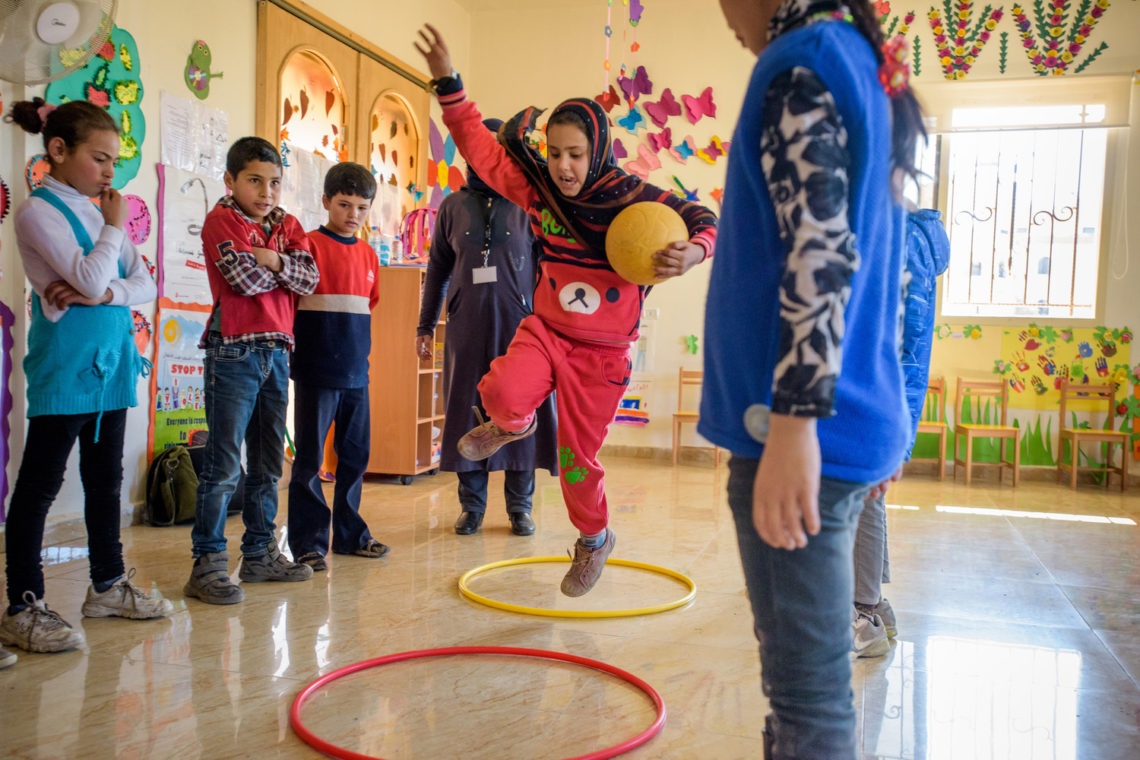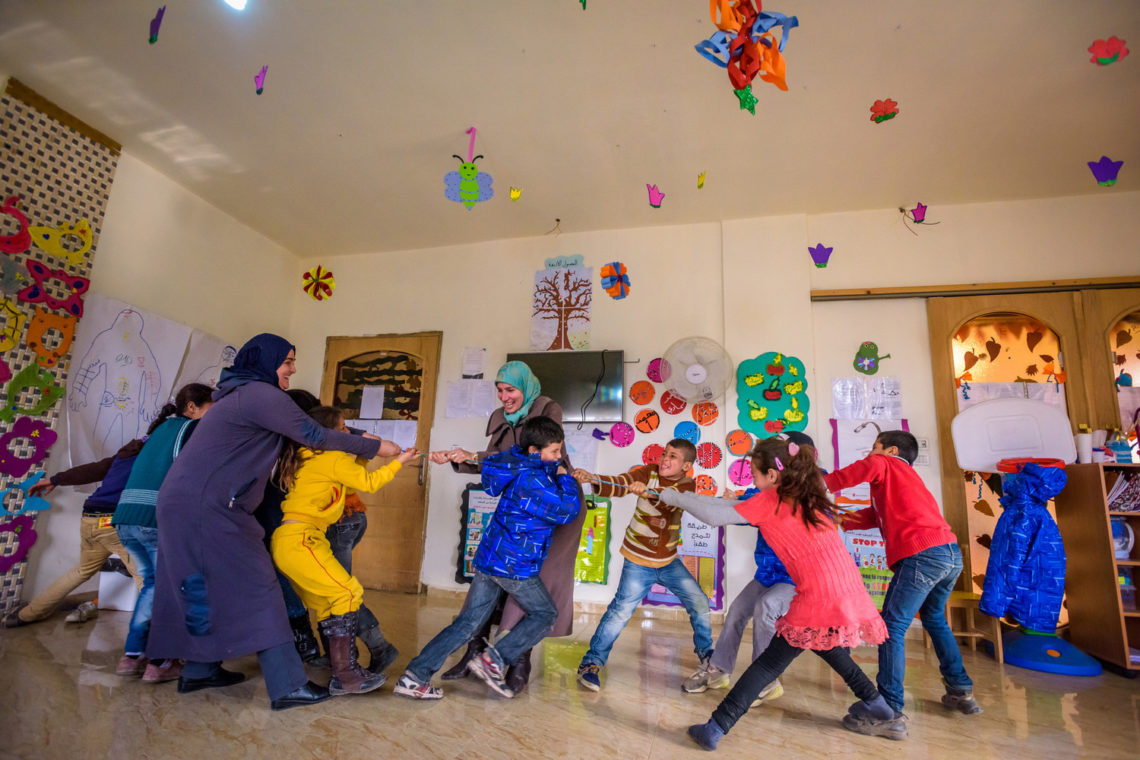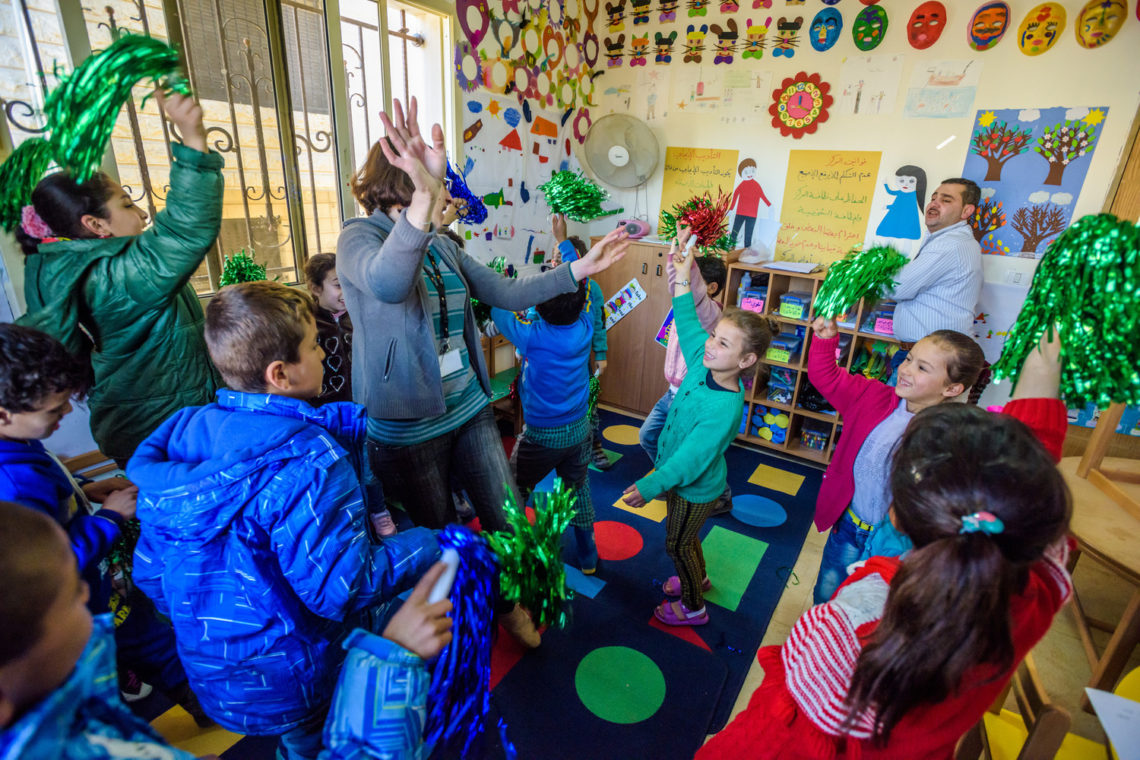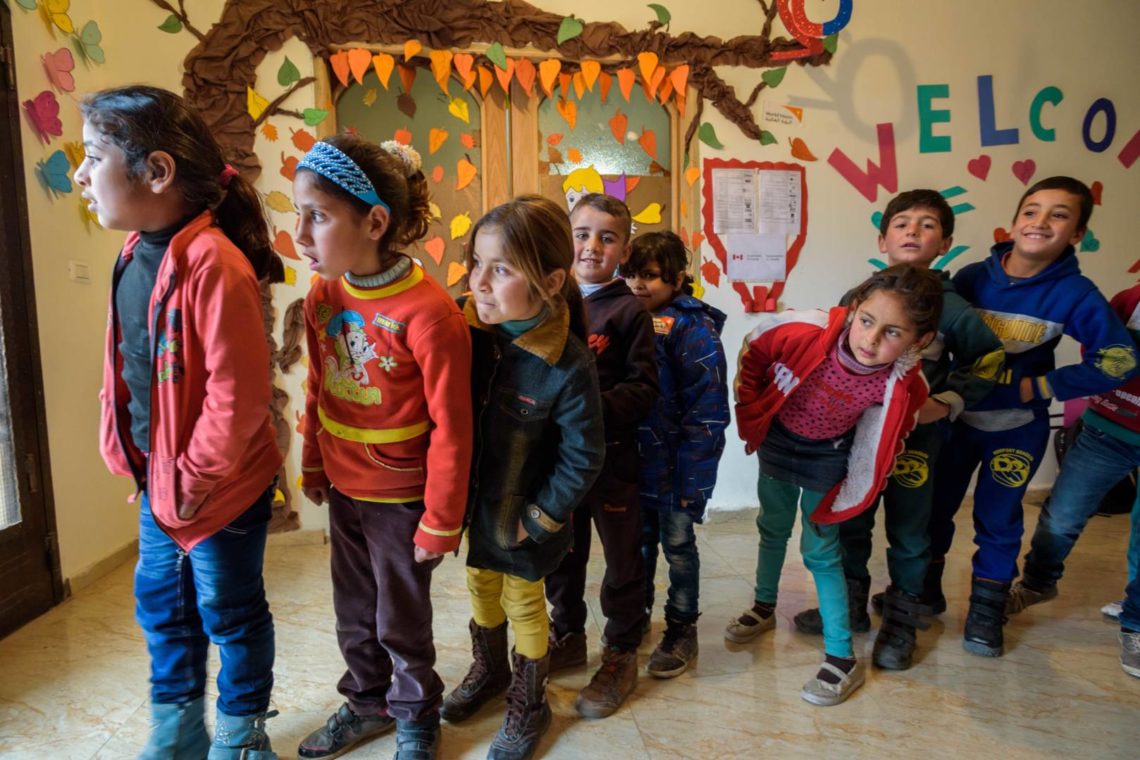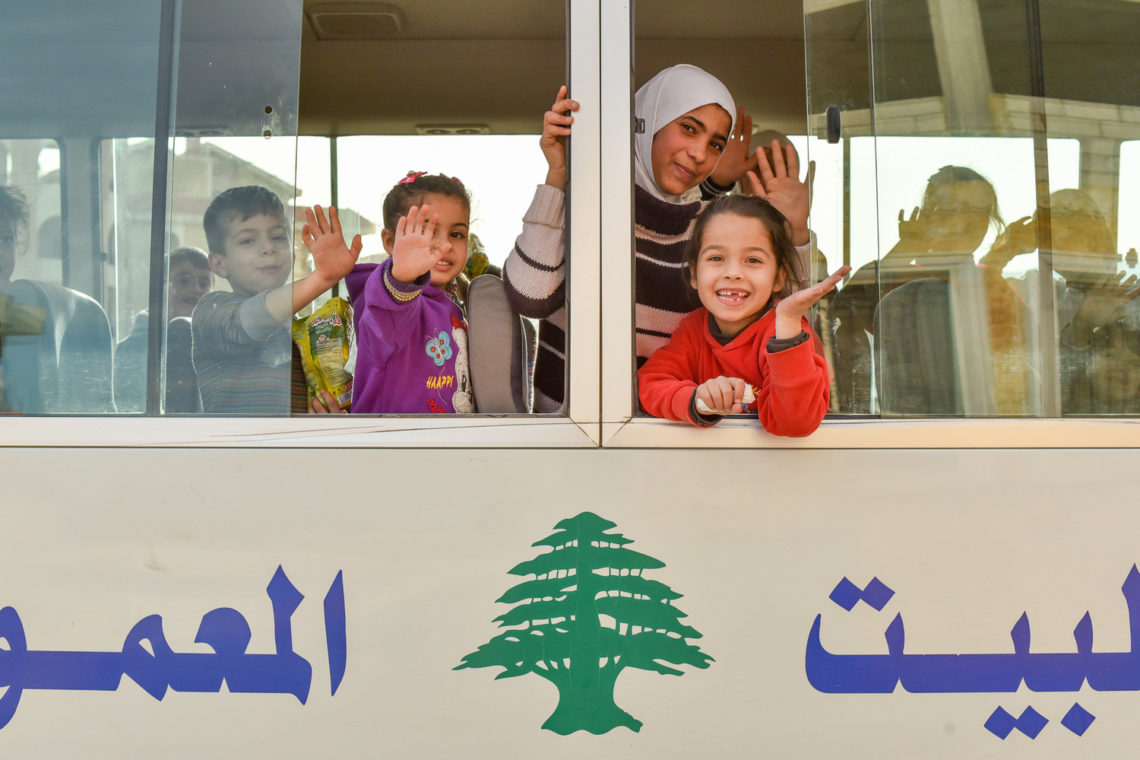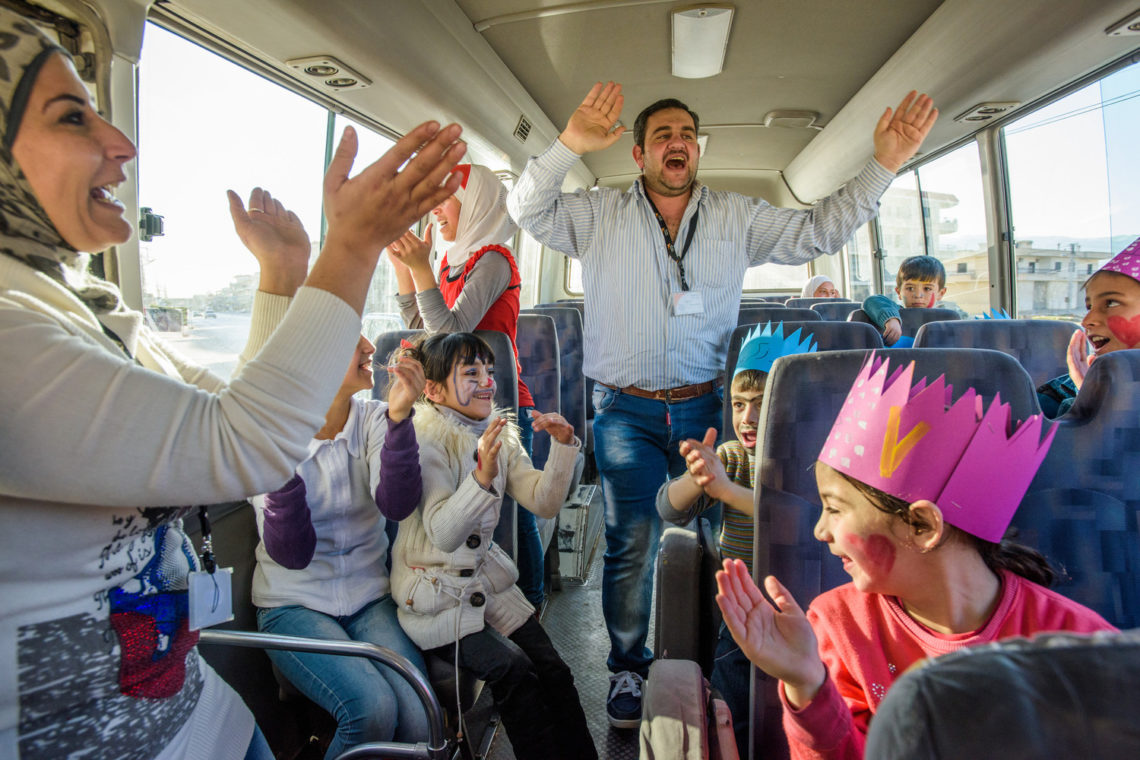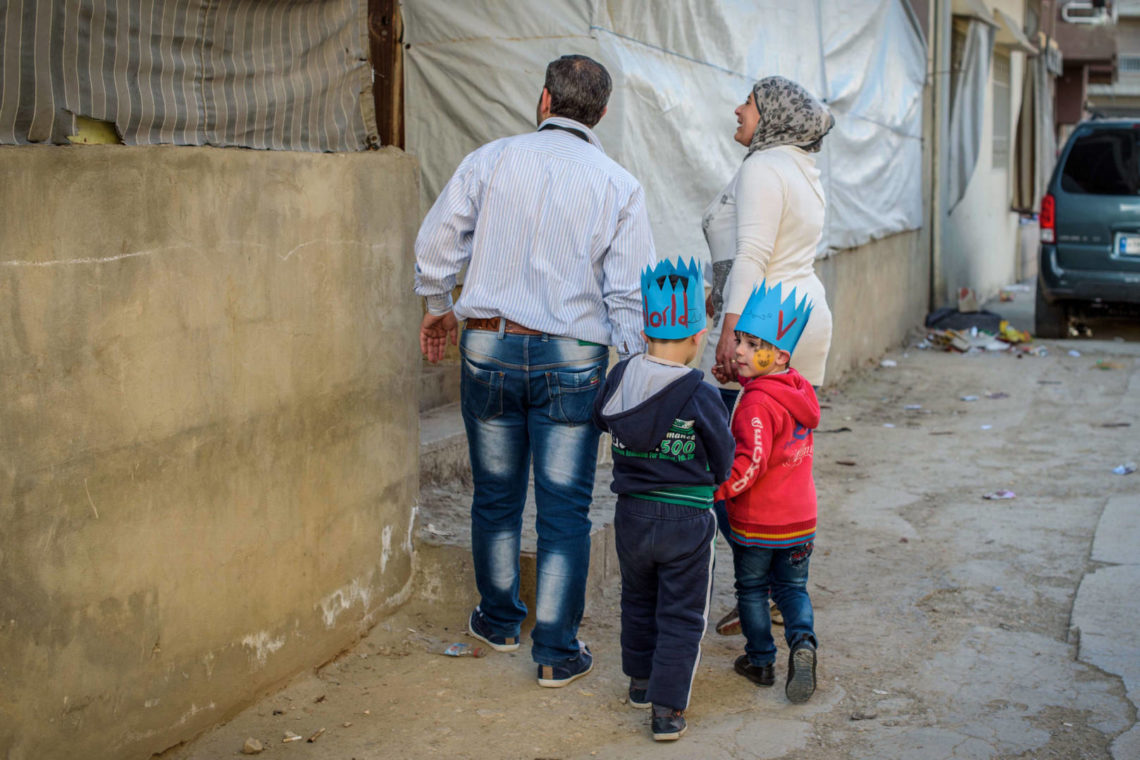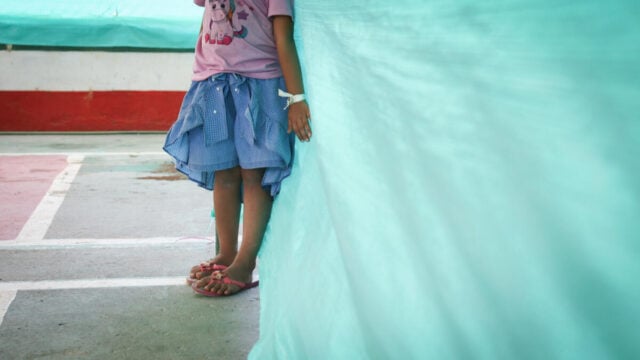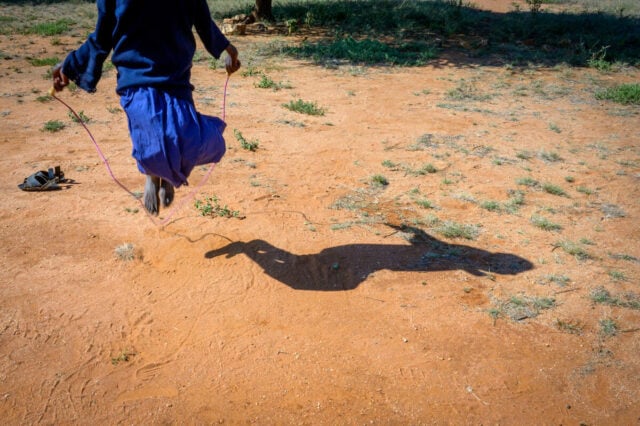About a dozen children talk excitedly and pick out drawing supplies for their next activity when 11-year-old Jouri’s voice rings out above the hubbub. Her song of a refugee’s solidarity with people left in Syria is as current as the daily news:
In a tent in Bar Elias;
a refugee, but my head held high.
Nobody has seen me,
and I still love you brother.
Classmates and teachers stop their chatting and surround her. They beat time to the rap-like rhythm and join in loudly on the chorus in Arabic.
The teachers, called “animators,” at the World Vision Child-Friendly Space can only marvel at Jouri’s confidence and composure. When Jouri first joined the Child-Friendly Space, she was fragile: quiet, withdrawn, and often close to tears, says Huda, one of the animators.
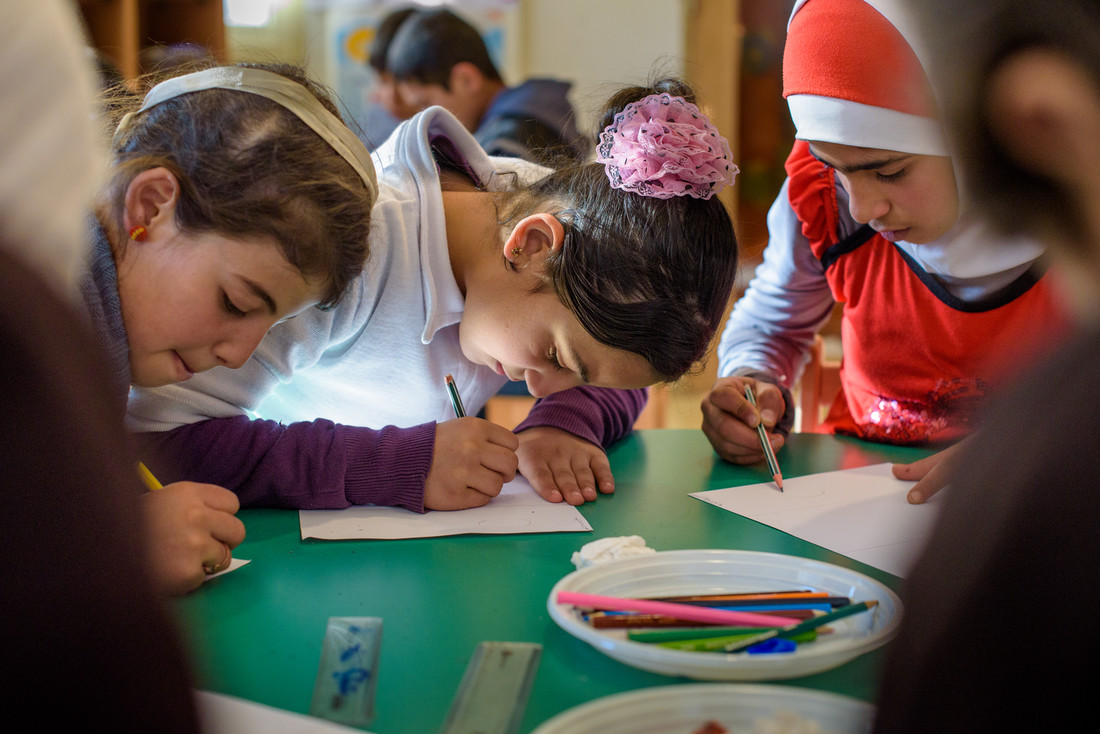
“We realized she could read well, and with emotion, and was able to tell stories,” Huda says. Jouri was named the class storyteller, a position she takes seriously. Now she participates in all activities with pleasure, especially storytelling, reciting poetry, and singing.
Her transformation seems near-miraculous.
At first glance, a Child-Friendly Space might seem like any kids’ activity center. On the walls, there are brightly colored construction paper cutouts of circles, squares, birds, butterflies, and flowers. The air is alive with songs and laughter. But here in Lebanon’s Bekaa Valley, only 30 miles from Damascus, Syria, the thud of bombs can be heard even closer. The warm and welcoming Child-Friendly Spaces and people who staff them provide an oasis in the bleak lives of thousands of Syrian refugee children.
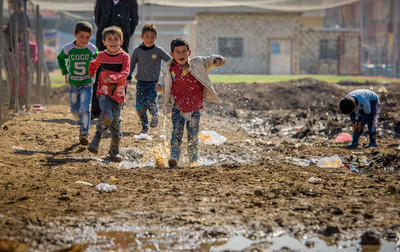
• One out of every four people living in Lebanon is a Syrian refugee. (Source: U.N.)
• The number of children not receiving an education due to the conflict in Syria totals about 2.8 million — more than if every child under 18 in Pennsylvania was out of school.
• Almost a third of the 2.3 million Syrian refugee children in the Middle East are not enrolled in any form of education, and within Syria, more than 2.1 million children aren’t in school.
(©2016 World Vision/photo by Jon Warren)
During 2015, World Vision assisted more than 12,000 children in Lebanon, Jordan, Syria, and Iraq with child protection and education programs. In Lebanon, these services include not only Child-Friendly Spaces, but also early childhood education for ages 3 to 6, digital hubs for computer learning, early childhood development classes for parents, and outreach for children and families with psychosocial needs.
Animators go to tent camps and neighborhoods where refugees live in unfinished buildings, registering children for an upcoming three-month term at the center. Once the children arrive, the animators start the hard work of helping them identify and understand their feelings.
As the class storyteller, Jouri draws on a deep well of emotion she had previously bottled up.
Sitting in their living room, Jouri begins her family’s story by saying, “When I was a child … ” Her mother and grandmother listen as she recounts fleeing from town to town; the time a blast from a car bomb destroyed the balcony and blew out the doors of a house where they were staying; and how her uncle, who brought them to Lebanon, died after he returned to Syria.
Those horrific experiences would be enough to shake anyone’s confidence. Jouri is haunted by a sense of loss and longing, says her mom, Haisha. Jouri’s father has been missing in Syria for most of the three years since the family came to Lebanon. When last seen, he was wounded. Jouri doesn’t know whether he’s dead or alive.
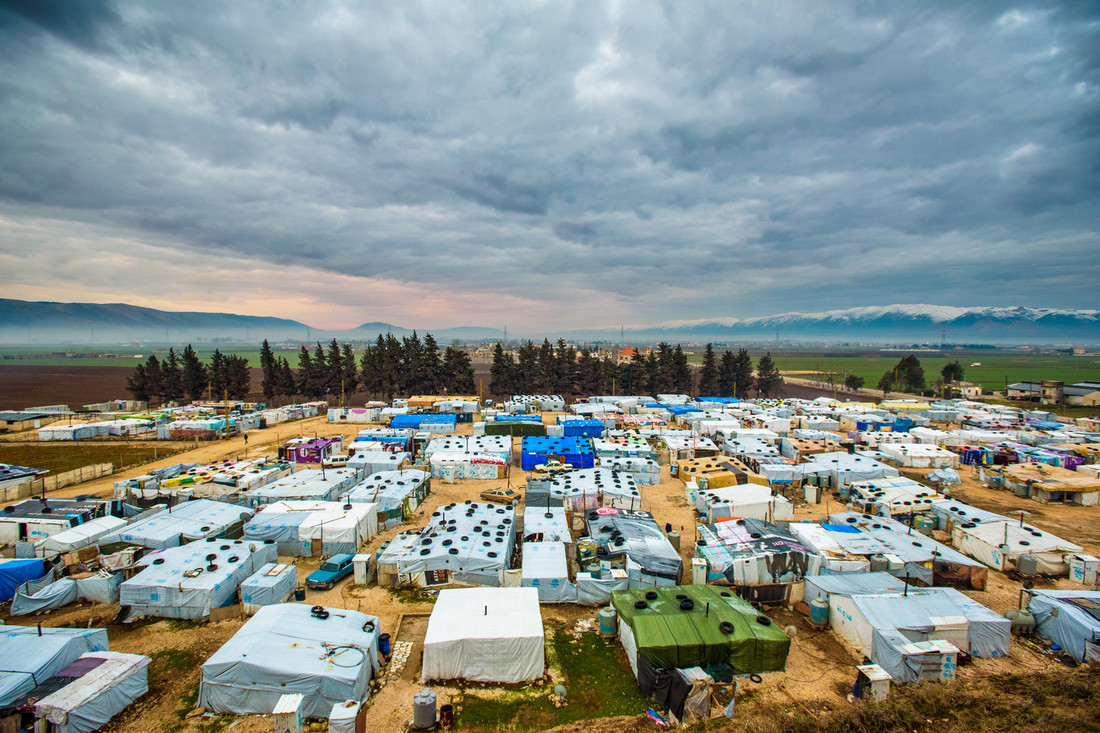
Exercising emotions
If there’s any hope for a healthy future for children who’ve suffered loss and displacement because of the Syrian civil war, learning to identify, express, and manage emotions is critical, says Alison Schafer, a World Vision specialist in mental health and psychosocial support.
“One part of the curriculum in Child-Friendly Spaces helps children to identify heroes in their lives who can inspire them to develop coping and problem-solving skills,” Alison says. “The children are strengthened by warm, supportive relationships with their peers and caring adults.”
Before the center, I didn’t have courage, but now I do.—Jouri, 9
Ahmad, an animator with Jouri’s group, is the picture of caring. “How do you feel today?” he asks the children standing with him in a circle. They’ve just played a series of exercise games to warm up and start the day.
Ahmad turns the dial on a handmade “mood wheel” to reveal pictures of different facial expressions. One by one the children call out how they feel and why.
“Happy! I’m happy to be here with my friends,” says one girl. “Sad,” says another, “because we heard bad news from Syria.” As Ahmad turns the wheel, the children name other emotions from the facial expressions pictured.
Ahmad and the other animators give the children opportunities to recognize and express feelings and to understand that feelings come and go. “We don’t ask about the things that trouble them,” says Bassima, the children’s center supervisor. “We are here to support and encourage them.”
Parents, as well as teachers, can participate in World Vision training on positive discipline, which teaches them to recognize their children’s challenges and help them solve problems. “This approach builds a child’s self-esteem and belief that they can take care of themselves,” says Elika Dadestan, World Vision’s interim global education in emergencies specialist.
“If we are sad, [the animators] make us feel better,” says Jouri. “Before the center, I didn’t have courage, but now I do.”
Failing grade for education
Jouri’s emotional resilience — that courage she traces to the Child-Friendly Space — is equal to what’s perhaps the biggest need and toughest challenge of her young life: getting an education. “Going to the space has made me a better student,” she says. Jouri attends school in the mornings and the Child-Friendly Space each afternoon. She credits the center for much of her success in school, where she’s just been named the top student in her class.
As months and years pass, they find it harder and harder to return.
“Now I’m not so shy. I’m better able to answer questions and read aloud in class,” she says.
Jouri is exceptional, not only because of her academic success but because she goes to school at all. In 2015, less than a quarter of the 400,000 Syrian refugee children in Lebanon were enrolled.
As months and years pass, they find it harder and harder to return.
Ten-year-old Shiraz loved her school in Syria, but it was destroyed three years ago. She quit school in Lebanon this year after the principal chided her for talking in class. “I was out one day, and when I came back I didn’t understand the instructions for a test, so I asked the girl sitting next to me,” she says. “After that [humiliation], I didn’t want to go back.”
Asked what her parents thought about her leaving school, Shiraz just shrugged. “Parents never tell us where to go or what to do, except not to leave the tent at night,” she says.
With no homework and little to do in the informal tent settlement where she lives, Shiraz runs with a pack of kids, often teasing and chasing the little ones. She doesn’t get along with her stepmother or feel close to her father. Her own mother left the family some years back.
Shiraz has two trusted friends, Iman and Bdour, at the Child-Friendly Space who have similar stories. “I went to school, but it was far away, and the teachers yelled at us,” says Iman. And Bdour says she registered, “but they never got back to us.”
Some parents believe work is more important
Parents who are struggling with their own losses and frustrations, as well as financial concerns, find it hard to navigate the education system and support their children to attend school. But not all parents understand their children’s need for psychological support, and some don’t see the connection between the program and the education they want their children to have.
“Some parents say their children don’t have time to play and draw — they have to work,” says Bassima, the center’s supervisor.
The last term, a lot of children were absent. “They had to dig potatoes; the landlord requires it,” says Huda. “Mostly girls or very young boys do the work because they work cheaper.”
When parents visit the center, however, they see what their children do there and how happy they are. “They say, ‘This is good for my child. He is better behaved and happy. Please let them keep coming,’” says Bassima.
As a parent herself, says Huda, “You have to be patient and work through the problems and support a child to go to school. It’s not easy.”
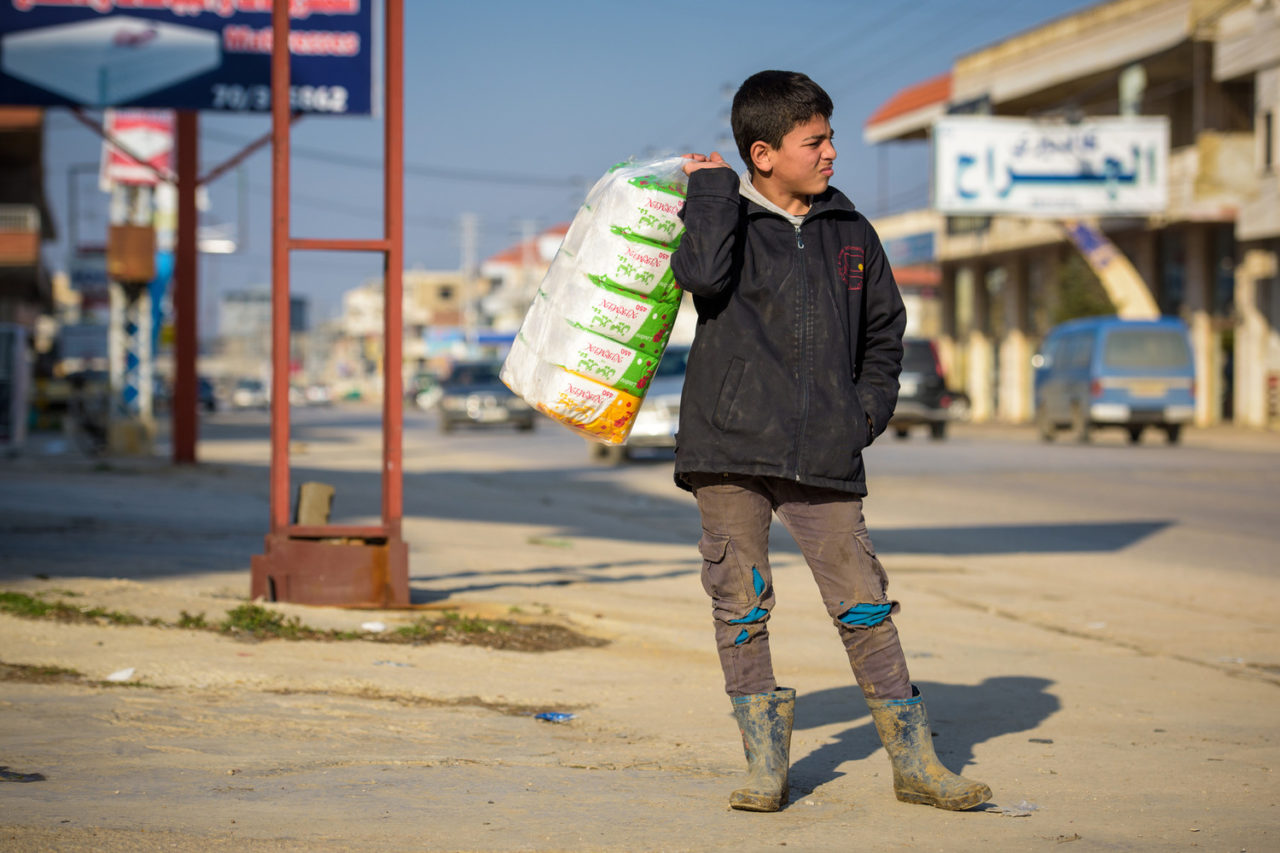
All work and no school
Ali says he’s 13. His mother, Heven, corrects him, “12, but soon he’ll be 13.”
The point is more than academic. Ali considers himself an adult. He takes pride in being the breadwinner for his family. His father is being treated for a nervous condition and is unable to work, Heven says. The family depends on Ali’s income from selling tissues to passing motorists on the Damascus Road to pay the rent.
There is no oasis of a Child-Friendly Space for Ali, no safe place to experience emotions and build courage. No school days. War and loss have stolen his childhood.
“Being the oldest of his brothers, he wants to be responsible to take care of the family,” says Heven. “He wants me to think he lives a normal life.”
Ali steels himself to face daily rejection, insults, and bullying. Sometimes he cries from the strain. Heven’s eyes brim with tears whenever she thinks of what he’s missing.
Ali has been out of school since before his family moved from Syria to Lebanon. “He should be in school; he should be in grade nine now,” Heven says, hanging her head.
Heven is adamant that education is what’s most important to her. “I don’t want [my children] to work in construction like other Syrians do. I want them to get a degree and have a decent career,” she says.
The family struggles financially and emotionally. Beyond daily survival, Heven can’t see how to give her children the life she wants for them.
Three weeks after World Vision opens an early childhood education center in the tent settlement where they live, Mohammed, Heven’s 4-year-old, is registered but not attending.
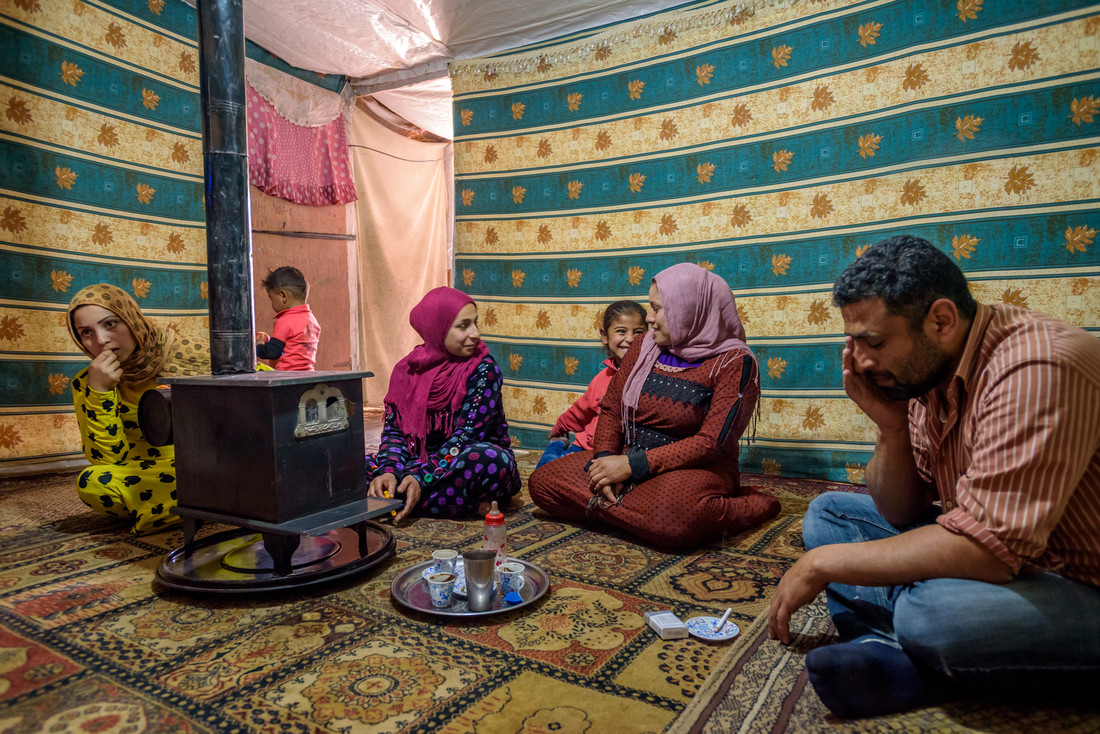
Nurturing with hope
‛This is Yasmin, like the flower,” says Huda, introducing a ponytailed girl with a blossoming smile. Yasmin, 9, sings with abandon, making big hand gestures and laughing with her friends. The Child-Friendly Space where she spends her weekday mornings is where she comes to life.
Children take home what they’ve learned at the center. They take the pictures they’ve made and hang them on the walls of their tents. They teach other children the games and songs they’ve learned. They share the lessons they’ve embraced about fair play and respect for others.
At noon, Yasmin rides the bus home from the Child-Friendly Space to the tent settlement where she lives. It’s dirty and depressing, in sharp contrast to the clean, colorful center. Yasmin walks cautiously along a muddy back alley between tents made of tarps and advertising posters.
“This is not a good place; not for kids,” says Ahmed, Yasmin’s father, as she enters the main living space of the tent. He and Yasmin’s mother, Khatar, try to make a good home, he says. He worries about conflict and crime. Feelings are raw within the camp, and locals are not always welcoming.
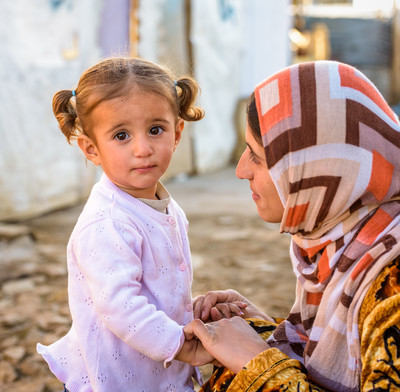
1. Pray for a swift end to the conflict in Syria.
2. Ask God to protect the most vulnerable refugees and displaced people, including children.
3. Praise God for churches in the Middle East that are serving refugees.
(©2016 World Vision/photo by Jon Warren)
Ahmed feels fortunate to have a job. Most days, he drives a truck an hour from Zahlé to Beirut, through the mountains. He supports his own family as well as provides what he can for relatives who stay with him and others still in Syria. Finances are stretched. He makes enough, however, so his children don’t have to work.
Khatar defies the dirt and disorder of the camp by keeping their tent as neat as a pin. She even made wall coverings from flour sacks scavenged from the trash dump. She washed and dried them by hand, then stitched them together and hung them.
Muddy shoes are left at the open doorway. There Yasmin, the eldest of five, plays school with the younger children or prepares a bottle for the baby while her mother makes lunch.
Then, in the afternoon, Yasmin and a few other children from the settlement ride another bus to a Lebanese school. Attending school challenges all of Yasmin’s strength and spirit.
Sometimes students are harassed, and the teachers are not always kind, she says. Yasmin’s younger sister, Abir, won’t go back since a teacher hit her hands. Often Syrian students struggle with subjects that are taught in English or French. In Syria, the classes were all in Arabic.
Yasmin, however, has the drive to succeed and the support she needs from her parents, teachers, and the Child-Friendly Space animators who encourage her.
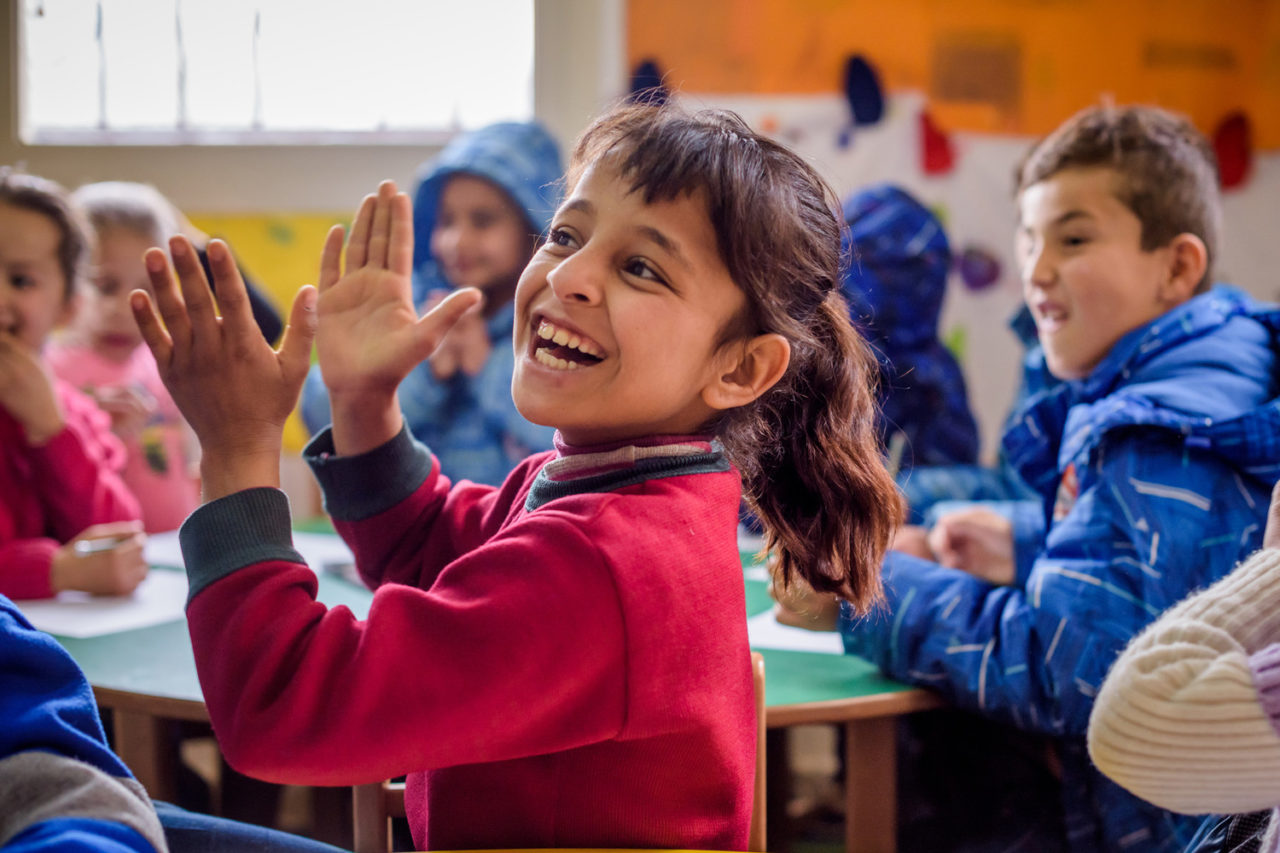
“When it snowed [and school was closed], she wanted to go,” says Khatar. “Her teacher says she is the second in her class; she needed just one more point to be first. That’s out of about 30 children in the class.”
A drawing Yasmin made at the center explains how she views the past, present, and future of her life: “That’s my mother, father, and brother by our beautiful house in Syria. The day is sunny and there are butterflies,” she says of the past. Her parents worked for years to build their dream home in Syria. Instead of moving in, they had to flee.
The high point of Yasmin’s life in the present is the Child-Friendly Space she attends every day.
“In the future, I want to be a teacher in Syria. That’s a cabinet with books in the classroom. I’ll give gifts to all the students,” she says.
Says her mother, “Our future is gone, but [the children’s] future is our responsibility. We had our bad luck, but what we must do now is make a better life for them.”
